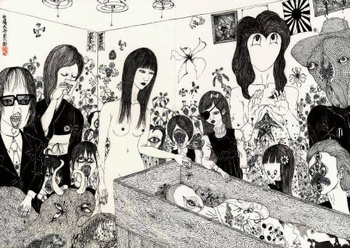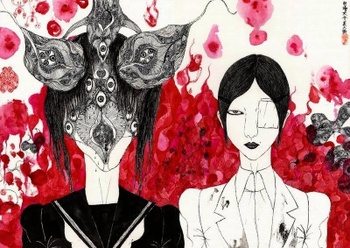Galerie E² has brought a Japanese master to Brussels: Daisuke Ichiba. With a gentle hand and a sharp knife, he connects the thin layer of human beauty with the visceral matter that lies beneath.
Daisuke Ichiba scrapes the thin layer of civilization off the world and at the same time shows the human paradox.
Also read: Arpaïs Du Bois: Fenêtres intranquilles
Since it first surfaced in Vitrine 5 of Recyclart in the spring of 2014, the nomadic Galerie E2 has made it its mission to delve deep in the underground to emerge with raw and uncut gems. A profound darkness of the most colourful kind has become the hallmark of the crew that for a while now has found a permanent hide-out aboveground at Sterput. And that is no different in their new exhibition featuring the work of Daisuke Ichiba.
Since the late 1980s, the Japanese master has been drawing a magic-realist world inspired by Japanese iconography, the golden age of manga, rock-hard underground and avant-garde, the deepest crevices of the psyche, and the dense smoke that they emit in the form of nightmares, obsessions, and hallucinations.
“Put simply, I paint humanity,” is how he himself describes this. “Humans simultaneously combine tenderness and violence. Choosing to create work that is only beautiful feels artificial. Thus I paint both. You cannot sever the two.” The result is an oeuvre that immerses silent beauty in a turbulent and grotesque chaos, forging a harmony between brutal violence and fragile serenity.
School’s out forever
This precarious, paradoxical balance that “violence bijin painter” Daisuke Ichiba – bijin meaning “beautiful woman” – thus creates between the beautiful and the abject, has an exceptionally alienating and yet tantalizingly seductive effect.
At Sterput you can see drawings that are colourful, naïve, bursting with child-like chaos. But the majority are drawn predominantly in black and white, with one penetrating colour and great attention to detail, and they tenderly but also uncompromisingly depict a world on the edge of the abyss.

Daisuke Ichiba
Against a background of volcanic eruptions, slaughter, apocalyptic scenes, and blood-red, swirling skies, mutilated characters appear, half-eaten, mutated creatures and fleshy, hovering eyes. Caricatured, manga-like dolls stand in a landscape littered with infected bodies, a knife in their hand. Figures pose for an end-time class photo, a last supper, a triumphal portrait, severed heads in their fists, skulls in the arms.
In the centre of this décor we see female figures – from schoolgirls in uniforms to beautiful young women – who are indomitable, who continue to attest to a delicate, mysterious impassivity, their eyes apathetically focused on their interior.
Taboos are shattered, sex and death appear inextricably linked.
Sometimes they are marked by stigmata or other wounds, other times they are naked on a bed, just before committing harakiri. Taboos are shattered, sex and death appear inextricably linked. But they all wear this impenetrable, imperturbable expression.
Is it a way of bearing what is happening around them? To process what they have seen? What they, avenging angels, have done? Is it resignation? Heartlessness? What do they know that we don’t?

Daisuke Ichiba
Daisuke Ichiba scrapes the thin layer of civilization off the world, the mask off the face, and at the same time shows the human paradox tenderly and frankly: there can only be light in the darkness.
Daisuke Ichiba > 21/4, Sterput
Read more about: Expo , Expo van de week , Daisuke Ichiba
Fijn dat je wil reageren. Wie reageert, gaat akkoord met onze huisregels. Hoe reageren via Disqus? Een woordje uitleg.